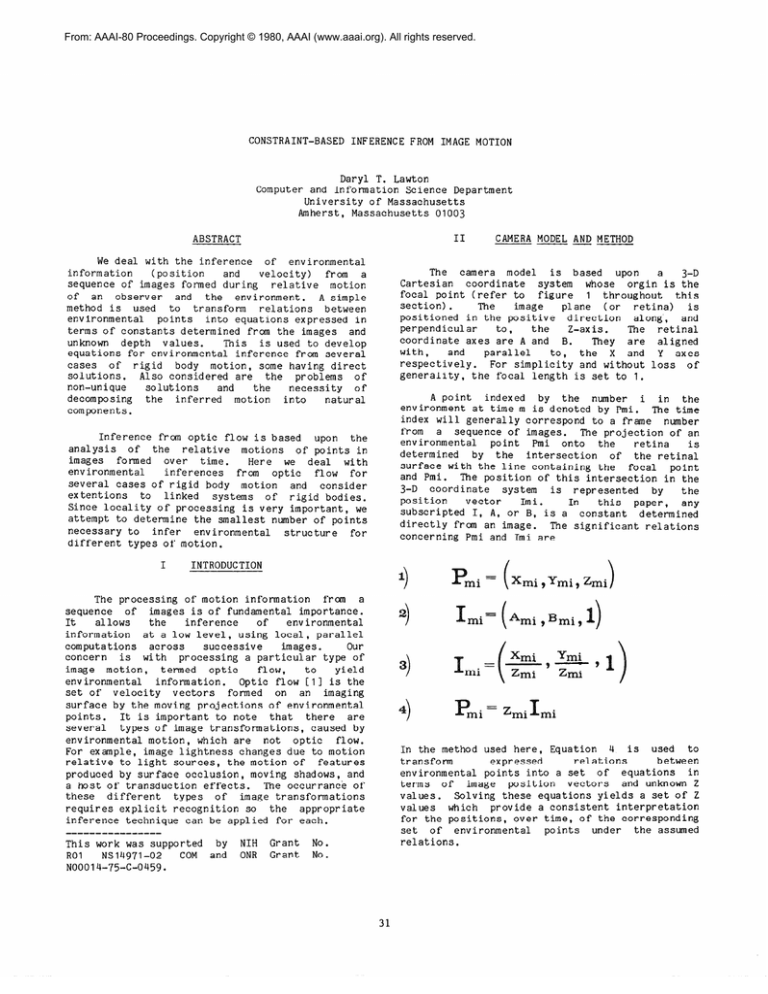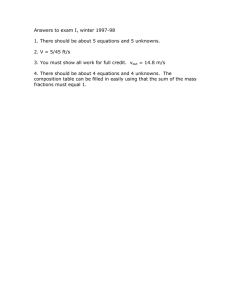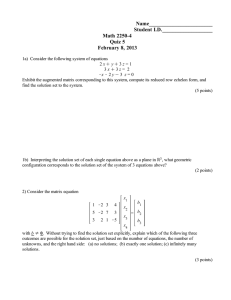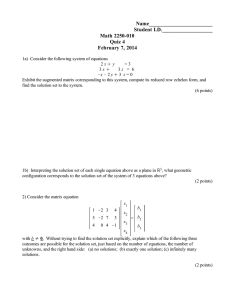
From: AAAI-80 Proceedings. Copyright © 1980, AAAI (www.aaai.org). All rights reserved.
CONSTRAINT-BASED INFERENCE FROM IMAGE MOTION
Daryl T. Lawton
Computer and Information Science Department
University of Massachusetts
Amherst, Massachusetts 01003
II
ABSTRACT
We deal with the inference of environmental
information (position and
velocity) from a
sequence of images formed during relative motion
of an observer and the environment. A simple
method is used to transform relations between
environmental points into equations expressed in
terms of constants determined from the images and
unknown depth values.
This is used to develop
equations for environmental inference from several
cases of rigid body motion, some having direct
solutions. Also considered are the problems of
non-unique solutions and
the
necessity of
decomposing the inferred motion into
natural
components.
Inference from optic flow is based upon the
analysis of the relative motions of points in
images formed over time.
Here we deal with
environmental inferences from optic flow for
several cases of rigid body motion and consider
extentions to linked systems of rigid bodies.
Since locality of processing is very important, we
attempt to determine the smallest number of points
necessary to infer environmental structure for
different types of motion.
I
CAMERA MODEL AND METHOD
----
The camera model is based upon
a
3-D
Cartesian coordinate system whose orgin is the
focal point (refer to figure 1 throughout this
section).
The
image
plane (or retina) is
positioned in the positive direction along, and
perpendicular to,
the
Z-axis.
The retinal
coordinate axes are A and B.
They are aligned
with,
and
parallel
to, the X and Y axes
respectively. For simplicity and without loss of
generality, the focal length is set to 1.
A point indexed by the number i in the
environment at time m is denoted by Pmi. The time
index will generally correspond to a frame number
from a sequence of images. The projection of an
environmental point Pmi onto the
retina
is
determined by the intersection of the retinal
surface with the line containing the focal point
and Pmi. The position of this intersection in the
3-D
coordinate system is represented by
the
position vector
Imi.
In
this paper, any
subscripted I, A, or B, is a constant determined
directly from an image. The significant relations
concerning Pmi and Imi are
INTRODUCTION
I
>
The processing of motion information from a
sequence of images is of fundamental importance.
inference of
environmental
allows
the
It
information at a low level, using local, parallel
Our
computations across
successive
images.
concern is with processing a particular type of
yield
image motion, termed optic
flow,
to
environmental information. Optic flow [ll is the
set of velocity vectors formed on an imaging
surface by the moving projections of environmental
points. It is important to note that there are
several types of image transformations, caused by
environmental motion, which are not optic flow.
For example, image lightness changes due to motion
relative to light sources, the motion of features
produced by surface occlusion, moving shadows, and
a host of transduction effects. The occurrance of
these different types of image transformations
requires explicit recognition so the appropriate
inference technique can be applied for each.
---------------This work was supported by NIH Grant NO.
COM and ONR Grant No.
ROI
NS14971-02
NO001 4-75-C-0459.
2
3
4
( X mi9 Yrni, Zmi J
>
>
)
=
mi
i
=
In the method used here, Equation 4 is used to
between
relations
expressed
transform
environmental points into a set of equations in
terms of image position vectors and unknown Z
values. Solving these equations yields a set of Z
values which provide a consistent interpretatiOn
for the positions, over time, of the corresponding
set of environmental points under the assumed
relations.
We begin with the number of unknown Z values.
N (N>2) points in K (K>l) frames there are
term
The minus 1
(NK)-1
unknown
Z values.
reflects the degree of freedom due to the loss of
one
of
the
absolute scale information. Thus,
Z-values can be set to an arbitrary value.
For
The number of rigidity constraints generated
by a set of N (N>2) points in K (K>l) frames is
the product of 3*(N-2) and (K-1). The first term
is the minimum number of unique distances which
must be specified between pairs of points, in a
body of N points, to assure its rigidity. Thus 4
points require 6 pairwise distances (all that are
possible). For configurations of more than 4
points, its is necessary to specify the distance
of each additional point to only 3 other points to
assure rigidity. The second term is the number of
interframe intervals. Each distance specified
must be maintained over each interframe interval.
The number of constraints is greater or equal
to the number of unknowns when
Retina
Fig. 1
III
A.
INFERENCE ---FROM RIGID BODY MOTION
Thus minimal solutions (But
unique!
see
below)
can
(N=5,K=2,number of constraint
(N=4,K=3,number of constraint
agreement with [2].
Arbitrary ---Motion of Rigid Bodies
The constraint equations developed for this
case reflect the preservation of distances between
pairs of points on a rigid body during motion.
For two points i and j on a rigid body at times m
and n, the preservation of distance yields
5
>
i
=
i
The rigidity equations can be simplified by
adding
restrictions on allowable motions of
environmental points. In the following sections
we investigate two such restrictions.
-
B.
which expands into the image-based equation
6
Motion Parallel -P-P
to the XZ Plane
Here the Y component of an environmental
point is assumed to remain constant over time.
Otherwise its motion is
unrestricted.
This
corresponds to
an observer moving along an
arbitrary
path in a plane,
maintaining
his
retina
at an Orientation perpendicular to the plane, with
the motion of objects also so restricted. For
Point i at times m and n this is expressed as
>
9
+2Zniznj(1nio
not
necessarily
be
found
when
equationszg) or
equations=l2), in
>
Lj)
-0
10)
To determine a solution, we find the minimum
number of points and frames for which the number
form
of
of independent constraints (in the
equation 6) generated equals or exceeds the number
It is then necessary to
of unknown Z values.
solve the resulting set of simultaneous equations.
Note that each such constraint is a second degree
polynomial in 4 unknowns.
Ymi
=
Zmi
Bmi=
Z ni=Zmi-
Zni
Bni
“Yni
Bmi
Bni
This allows a substitution, for points i and
which simplifies the rigidity constraint to
32
j,
translation
Thus environmental inference from
A potential
requires 2 points in 2 frames.
implication of this case is for interpreting
necessarily rigid body,
not
arbitrary, and
environmental motion. If the resolution of detail
and the rate of image formation relative to
environmental motion are both very high, then, in
general, the motion of nearby points in images can
result
of
the
be locally approximated as
translational motion in the environment.
D.
constraints
easily
The
rigidity
are
solved
using
differentiable
and
can
be
conventional optimization methods (taking care to
avoid the solution where all the Z-values equal
of
There are, however, in the case
zero>.
arbitrary rigid
body motion , generally many
solutions. Here we consider ways of dealing with
this.
-where the bracketed expressions are constants
determinable from an image.
This case has a
direct solution using 2 points in 2 frames.
To
see this, consider points 1 and 2 at times 1 and
2.
This yields a
system
of
4
unknowns:
211,212,221,222.
The substitution allowed by
equation 10 reduces it to a system of 2 unknowns,
Zll
and 212.
Zll can then be set to an arbitrary
value9 reflecting scale independence. 212 is then
determined from a constraint of the form of
equation 11 rel$ing
212 and
the
evaluated
variable Zll .
This is a quadratic equation of
One way utilizes feedforward. It is crucial
to note that the rigidity equations needn’t be
solved anew at each point in time.
If the
environmental structure has been determined at
time t and an image is then formed at time t+l,
half the unknowns in the system of constraint
equations disappear.
simplifies
This greatly
finding a solution. Additionally, the solution
process can be further simplified by extrapolation
of infered motion, if enough frames have been
processed. But how can the positions of the
environmental points be determined initially? I> .
Prior knowledge of the environment could supply
the initial estimates of the relative positions.
There may be a small number (perhaps less
2).
than 50) of generic patterns of image motion
(which may be termed flow fields), each associated
with a particular class of environmental motion.
For example, translational motion is characterized
by straight motion paths which radiate from or
converge to a single point on the retina.
Other
flow fields we have analyzed also have such
distinguishing
characteristics.
These
characteristics would
be
used to recognize
particular types of image motion, associated with
particular types of environmental motion, to
initialize and constrain
more
the
detailed
solution
the
solving
process based
upon
constraints for arbitrary rigid body motion.
3).
The observer could constrain his own motion for
one sampling period to a case of motion for which
environmental strutture
can be unambiguously
determined. For example, by stabilizing
the
retina of a moving observer with respect to
rotations relative to a stationary environment,
all image motion could be interpreted as the
result of translation.
212.
C.
Translations
The constraint expressing the translation of
points i and j on a rigid body at times m and n is
12
13
I=
j
j
>
-
i-
>
ii
where the operation is vector subtraction. This
and
1 ength
preservation of
the
reflects
orientation under translation. Setting Zmi to a
constant value C, to reflect scale independence,
in equation 13 yields 3 simultaneous 1 inear
equations in 3 unknowns
CAmi
=
CBd
=ZmjBmj+ZniBni-ZnjBnj
=
+z,i
zlTlj
C
ZmjAmj
+ ZniAni
-
Solving the Constraints
A-
ZnjAnj
-Znj
Another possibility is to use more than the
minimum required number of points in the inference
process to supply additional constraints.
33
IV
A.
APPROACHES ----TO OTHER CASES OF MOTION
ACKNOWLEDGEMENTS
I greatly appreciate Ed Riseman, Al Hanson,
and Michael Arbib for their support and the
I
intellectual environment they have created.
would also like to acknowledge the last minute
(micro-nano-second!)heroics of Tom Vaughan, Earl
Billingsley, Maria de LaVega, Steve Epstein, and
Gwyn Mitchell.
Sub-Minimal Rigid Configurations
A sub-minimal configuration is one consisting
of I,2 or 3 points over an arbitrary number of
frames or 4 points in 2 frames.
Human subjects
can get an impression of 3-D rigid motion from
displays of such configurations [4], even though
there are not sufficient generated constraints, by
the above analysis, for a solution. How is this
possible?
REFERENCES
Other assumptions must be used for
the
inference. A potential one reflects an assumption
of smoothness in the 3-D motion. This can be had
by minimizing an approximation of the acceleration
of a given point. For a point i at times t, t+l,
t+2 this can be expressed as
15)
Gibson, J.J. The Perception of -the Visual
World.
BostoG-- Houghton Mifflin and Co.
1950.
c21
Ullman, S.
The Interpretation of Visual
Motion.
Cambridge, Massachusetts:‘ The MIT
Press. 1979.
[31
Rogers, D.F. and Adams, J.A.
Mathematical
Elements for Computer Graphics. McGraw-Hill
Book Company. 1976.
c41
"Percieved
Johansson, G., and Jansson, G.
Rotary Motion from Changes in a Straight
Line." Perception and Psychophysics, 1968,
Vol. 4 (3).
151
Perception
of
Johansson,
G,
"Visual
Biological Motion and a Model for its
Analysis." Perception and Psychophysics 14:2
(1973) 201-211.
-
C61
Rashid, R.F.
"Towards a System for the
Interpretation of Moving Light Displays",
Technical Report 53, Department of Computer
Science, University of Rochester, Rochester,
New York 146727, May 1979.
Ipti- pt+l,iI - Ipt+l,i-pt+Z,i
Perhaps a sum of such expressions, formed using
equation 4, should be
substitution of
the
minimized for a set of points over several time
periods along with the satisfaction of expressible
rigidity constraints.
B.
Cl1
Johansson --Human Dot Figures
Experiments initiated by Johansson have shown
the ability of subjects to infer the structure and
changing spatial disposition of humans performing
various tasks with only joint positions displayed
over time [53.
such
Here we consider
how
inference could be performed.
First, it is necessary to determine which
points are rigidly connected in the environment.
Work by Raschid C63 as shown that this is possible
on the basis of image properties only, using
relative rates of motion between images. That is,
without any inference of environmental structure.
Given the determination of rigid linkages, it
is
necessary
to
find the relative spatial
disposition of the limbs. An approach is to infer
environmental position, for each limb, using the
rigidity constraints and optimizing the smooth
motion measure discussed above. If the figure is
recognized as being human, several object specific
constraints can also be used. These would involve
such things as allowable angles of articulation
between limbs, their relative lengths, and body
symmetries.
34




